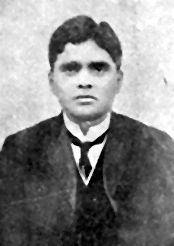Tanguturi Prakasam
Tanguturi Prakasam | |
|---|---|
Prime Minister of Madras Presidency | |
| In office 30 April 1946 – 23 March 1947 | |
| Governor | Henry Foley Knight Archibald Nye |
| Preceded by | Governor's rule |
| Succeeded by | O. P. Ramaswamy Reddiyar |
| Personal details | |
| Born | Tanguturi Prakasam 23 August 1872 Freedom Fighter Lawyer Politician Writer Statesman |
| Nickname | Andhra Kesari |
Tanguturi Prakasam popularly known as Prakasam Pantulu (23 August 1872 – 20 May 1957), was an Indian jurist, political leader, social reformer, and
Early life
Tanguturi Prakasam was born into a
When E. Hanumantha Rao, his teacher at school, moved to
In England
During one of his professional visits to Madras on a court case, a barrister was impressed with his legal acumen and suggested that he become a barrister. As a second-grade pleader, Prakasam could not argue cases at higher courts as only barristers were allowed to do so. Prakasam took the idea to his heart and decided to go to England to pursue legal studies. It was considered a sacrilege to cross the seas during those days. However, as Mahatma Gandhi had done before him, Prakasam made a promise to his mother that he would abstain from eating non-vegetarian food, smoking and drinking. He reached England in 1904. In England, he joined the Royal India Society and worked for the election of Dadabhai Naoroji to the House of Commons.
In the service of public

After completing the barrister course with a certificate of honour in London, Prakasam relocated to Madras high court. He was one of the only
Prakasam ran a national school and a
Andhra Kesari appellation and struggle for independence
When the Simon Commission visited India, public decided to boycott it with the slogan "Simon, go back". There were a host of reasons for this boycott, the most important being that the commission did not have a single Indian in its ranks. The commission was greeted with demonstration of black flags wherever it went. When the commission visited Madras on 3 February 1928, Prakasam Pantulu gave the slogan "Go back Simon Commission".The English soldiers warned the demonstrators headed by Prakasam. They threatened to shoot if they (the demonstrators) moved an inch forward. Prakasam Pantulu baring his chest came forward. This made the British soldiers dumb struck. This exemplary courage earned him the title "Andhra Kesari". After this incident, he was known respectfully as "Andhra Kesari" (the Lion of Andhra).

In 1930, when the Congress party wanted all the legislators to resign, he did so but was not convinced about its alternative programme and hence contested and won the by-election. He joined the
In 1937, Congress Party contested the provincial elections and achieved majority in

Prakasam was arrested and jailed for more than three years for participating in the
Premier of Madras Presidency
In 1946, after the Congress' victory in elections in


During his tenure as Premier, Prakasam publicly declared his intention to scrap all existing textile industries in the province and replace them with khadi manufacturing and weaving units.[3] In February 1947, Communists broke into a full-scale revolt.[3] On Vallabhbhai Patel's advice, Prakasam responded with widespread arrests and tough crackdown on arsonists.[3]
| Prakasam's Cabinet | |
|---|---|
| Portfolio | Minister |
| Prime Minister | Tanguturi Prakasam |
| Labour and Industry | V. V. Giri |
| Health | Rukmini Lakshmipathi |
| Food | T. S. S. Rajan |
Post-independence
Prakasam visited
In 1952, he formed the Hyderabad State Praja Party (Hyderabad State People's party) and ensured that all the sitting ministers of the Congress Party were defeated.[citation needed] However, Praja party could not come into power by its own and the coalition that he put together collapsed even before a show of strength could be contemplated.
Meanwhile, in December 1952,
] near Ongole, he suffered from severe sunstroke. He was admitted to a Hyderabad hospital and died there on 20 May 1957.Institutions named after Prakasam
- Andhra Kesari University, Ongole
- Sri Tanguturi Prakasam Memorial Institute of Advance Studies in Education, Nellore, SPSR Nellore Dt, Andhra Pradesh. [STPM IASE]
- Sri Prakasam Government Junior College & High School (1974) – Addanki, Prakasam district
- Andhra Kesari Centenary Junior College Degree College – Rajamahendravaram
- Prakasam Engineering College – Kandukur, Prakasam district
- Sri Tanguturi Prakasam Pantulu Government Junior College – Yanam, Yanam district (near East Godavari district)
- Andhra Kesari Yuvajana Samiti – a socio-cultural organisation, est. 1962
- Andhra Kesari Prakasam Junior College – Chirala, Prakasam district
- Prakasam Public School – Inkollu, Prakasam district
- Andhra Kesari Vidya Kendram Junior College – Ongole, Prakasam district
- Sri Prakasam Vidya Niketan High School, Anand Nagar Colony, Hyderabad district
- Andhra Kesari Tanguturi Prakasam Pantulu Government High School (AKTP High School), Satyanarayana Puram, Vijayawada
- Prakasam centenary Memorial High school, Rajamahendravaram,
Places named after him
- Prakasam district, Andhra Pradesh
- Prakasam Nagar, Begumpet Telangana
- Prakasam Road,Tirupati
- Prakash Nagar (Prakasam Nagar previously), Rajamahendravaram
- Prakash Nagar, Visakhapatnam
- Andhra Kesari Nagar(A.K.Nagar), SPSR Nellore District,
- Nrithya Prakasha Varshini (Bangalore)-Dance school started by Prakasam Grand daughter Shyamala Muralikrishna
- Prakasam Barrage, Vijayawada.
Autobiography

Prakasam's autobiography is titled Naa Jeevitha Yatra (My Life's Journey) and published by Telugu Samithi. This book has four parts – the first two are about his early life and his involvement in freedom fighting in India, the third is about getting independence and government formation in Andhra Pradesh, and the last (written by Tenneti Viswanadham) discusses his political career and the changes he brought to Andhra. Emesco published them as a single hard cover edition in 1972.[citation needed]
See also
References
- ^ a b [1]- naajeevitayatrata-tanguturi-prakasham-gari-jeevita-charitra
- ^ 100 years of Gayopakhyanam, Andhra Pradesh, April 2010 edition, pp: 64.
- ^ a b c "Shocking Truth". Time. 10 February 1947. Archived from the original on 2 September 2009.
